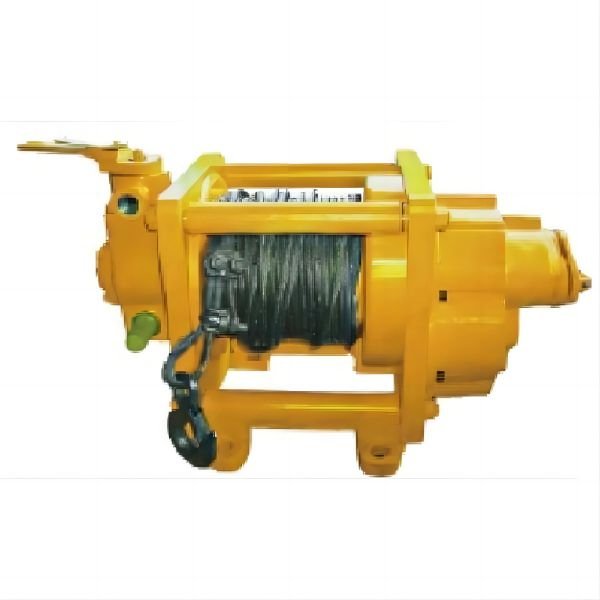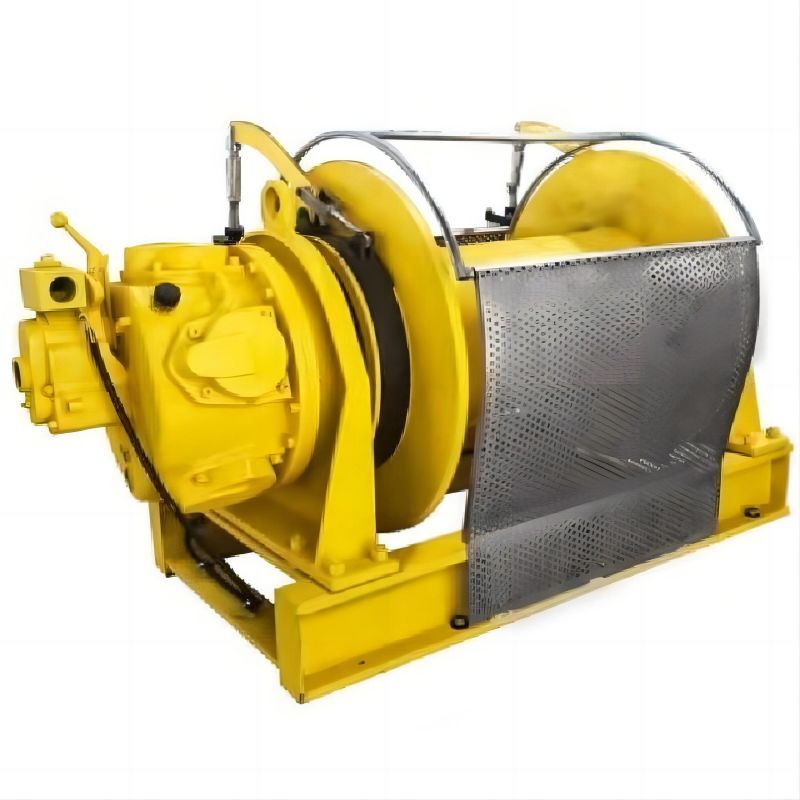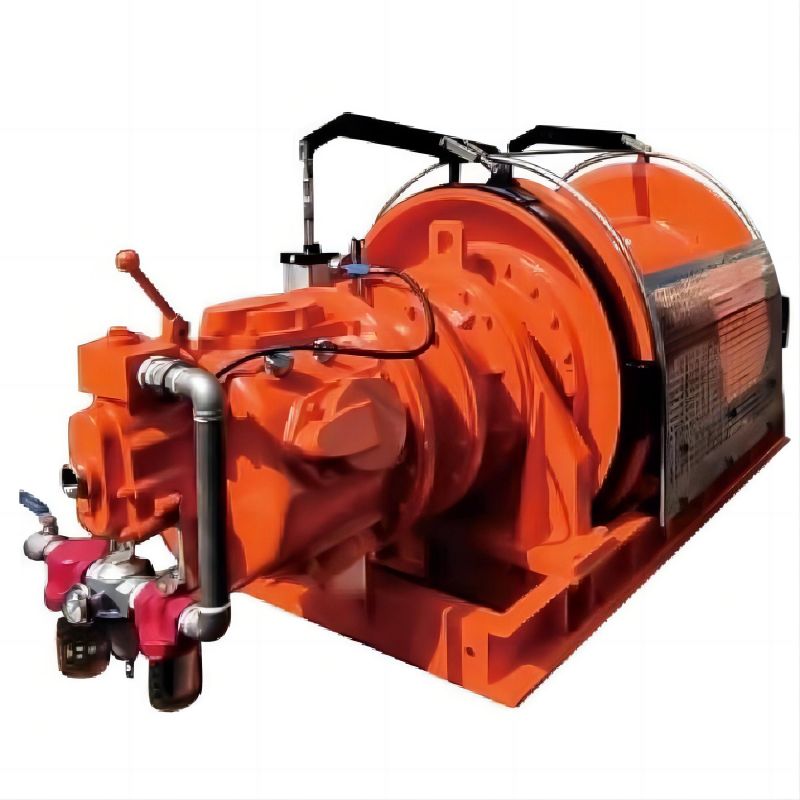OVERVIEWAND USE:
The QJH pneumatic winch is powered by an AMH piston-type air motor, designed for single-drum operation. primarily used in metal mines, coal mines, construction engineering, and oilfields for hauling and lifting heavy objects.
Its compact size, lightweight construction, adjustable speed, ease of handling, and quick installation make it particularly well-suited for underground operations in mining environments. It excels in tasks such as dispatching at loading stations, hauling mine trucks, and lifting and pulling heavy tools and instruments in narrow underground alleys.
With its robust design and versatile functionality, the QJH pneumatic winch is a reliable solution for various industrial applications, offering efficiency and convenience in demanding work environments.
STRUCTURE AND WORKING PRINCIPLE:
The structure and working principle of the QJH pneumatic winch are fundamental to its efficiency and functionality. Powered by compressed air, this winch employs a piston air motor and a reduction mechanism featuring internal and external gear transmission pairs. These components work in tandem to drive the drum operation, facilitating the winching process effectively. Key structures of the winch comprise air motors, gearboxes, drums, and brakes. Through this integrated design, the winch can deliver robust performance in various industrial applications, ensuring reliable lifting and hauling operations.
WINCH BRAKE:
Winch brake systems play a critical role in ensuring safety and control during winch operations. Here’s an overview of different types of winch brakes:
Manual Drum Brake (Standard): This type of brake is operated by a handle that can be pressed to engage the brake or pulled up to release it. When fully pressed, the handle locks, preventing the drum from rotating until it’s released. Proper adjustment is essential to maintain the required load.
Foot Brake (Standard): Comprising brake belt, steel belt, pedal, and other components, the foot brake functions similarly to a cylinder brake. However, it differs in that it’s only operational when the winch is in use. When the pedal is pressed, the brake belt and brake hub engage, increasing braking force with pedal pressure. It’s useful for short pauses during lifting operations or emergency braking when the winch is not actively controlled.
Cylinder Drum Brake (Optional Function): Consisting of brake belt, steel belt, and a self-centering cylinder, this brake offers adjustable braking force. Tightening the nut adjusts the tightness between the brake belt and the brake hub, allowing for varying levels of braking force. When the winch operates, compressed gas enters the cylinder, shrinking the piston rod to release the brake hub, enabling drum rotation. In the event of low air pressure or gas cutoff, a self-return spring tightens the brake belt to complete braking.
Automatic Disc Brake (Optional Function): These brakes utilize spring-braking and air-releasing mechanisms. An air-actuated, spring-loaded piston automatically disengages the brake when the motor runs, and the brakes engage when the throttle returns to the neutral position. Brake release occurs by overcoming spring pressure and moving the piston via air pressure in the brake housing.
It’s important to note that prolonged exposure to corrosive environments can cause band brake linings to adhere to the brake drum. During periods of inactivity, it’s recommended to leave the belt brake in the released position to prevent such adhesion.
Each type of winch brake offers distinct advantages and is suited for specific applications. Proper selection and maintenance of the brake system are crucial for ensuring safety, control, and efficiency during winch operations.

0.1T-8T pneumatic winch
KRC’s pneumatic winches provide safe, reliable lifting from 0.1T to 8T capacities for industrial applications. Powered by compressed air and controlled manually or remotely, these winches feature auto braking, flexible operation, light weight designs and corrosion resistant finishes.

10T-15T Pneumatic Winches
A series of heavy duty pneumatic winches from 10 ton to 15 ton capacity, adopt piston air motor drive, manual/remote control models, equipped with hand brake + air brake for safe lifting.

25T pneumatic winch
High-performance 25-ton winch powered by compressed air, featuring manual (optional remote) control, piston-type air motor drive, planetary reduction torque, automatic disc brake, and dual air brake for exceptional braking force, stability, and safety. Stainless steel 304 protective cover with marine anti-corrosion paint ensures durability.
LUBRICATION:
To ensure the air winch continues to operate smoothly, all lubrication points must be serviced with the correct lubricant at appropriate intervals according to each component’s specifications. Only use the recommended lubricants, as other lubricants may affect product performance.
Always use the recommended grade of oil to prevent damage to the winch and/or its associated components. Using improper oil can result in high temperatures, decreased efficiency, and potential damage to lubricated parts. Refer to the recommended lubricant table. Lubrication Interval
It is recommended to perform the first oil change after approximately 50 hours of initial operation. Subsequently, discharge and replace the oil according to the intervals specified for each component. Check the oil consumption of the air line lubricator daily.
Always inspect drained oil for signs of internal damage or contamination (metal shavings, dirt, water, etc.). Check the motor oil level and investigate and correct any signs of damage before resuming winch operation. Check the gearbox and disc brake oil.
Allow the oil to settle before topping up after product operation.
Collect lubricants in suitable containers and dispose of them in an environmentally safe manner. Replace the disc brake oil.
Pneumatic products use oil to prevent overheating and to guard against wear that could potentially cause sparks. Proper oil levels must be maintained to ensure the winch continues to operate smoothly. All lubrication points must be serviced with the correct lubricant at appropriate intervals according to each component’s specifications.
AIR SUPPLY:
To ensure optimal motor performance, the air supply must be clean, moisture-free, and properly lubricated. Premature motor wear and failure often result from foreign matter, moisture, or insufficient lubrication. Utilizing air filters, lubricators, and moisture separators enhances product performance and minimizes unplanned downtime.
Installation of air line lubricators, filters, and regulators close to the motor air intake is crucial. The lubricator should be positioned within a 3-meter radius from the motor. Additionally, consider mounting the airline accessory kit on a winch guard plate, either on the operator’s side or opposite, for convenient access.
Proper maintenance of the air supply system is vital for the efficient operation of winches and other pneumatic equipment. Regular checks and replacements of filters, lubricators, and moisture separators are recommended to uphold performance standards and prolong the lifespan of the equipment.
INSTALLATION:
During the installation of the winch, it’s crucial to handle it with care, especially when moving or positioning it. Lifting lugs are typically provided to aid in carrying the winch, but if they’re not suitable for your specific installation, take special care to ensure proper balance during lifting.
Ensure that the winch is installed with the drum axis horizontal and the distance between the air motor ventilation cap and the vertical center of the top not exceeding 15 degrees. If you intend to install the winch in an inverted position, rotate the motor housing accordingly, positioning the ventilation cap on top.
The mounting surface for the winch must be flat and robust enough to support the rated load along with the weight of the winch and any additional equipment. Insufficient foundation strength can lead to deformation or twisting of the winch column and side rail, resulting in damage.
When securing the winch, use Class 8 or higher mounting bolts, along with self-locking nuts or nuts with locking washers. Ensure that the angle between the pulley set and the winch does not exceed 1-1/2 degrees. Additionally, align the guide wheel with the drum’s centerline and avoid welding it to any part of the winch.
Proper installation is essential for the safe and efficient operation of the winch, ensuring longevity and optimal performance in various industrial settings.